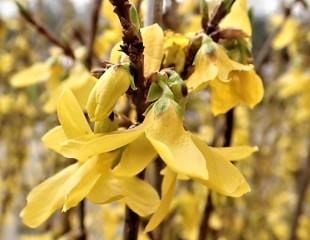
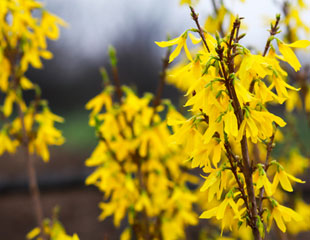
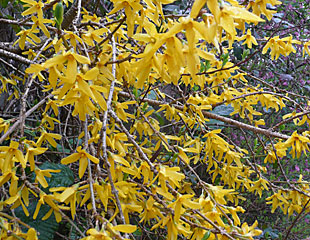
How to Grow Forsythia
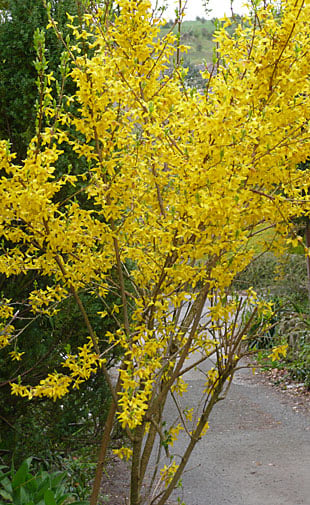
Forsythia is a popular, easy to grow, spring flowering deciduous shrub.
Forsythia has bright yellow flowers in early spring ahead of the leaves, which form in March through to April. This means the flowers are carried on bare branches and after flowering, the shrub comes into leaf.
Forsythia is popular and many gardeners grow them. Being so commonly seen and grow, some can be sniffy about Forsythia, but its lovely bright yellow is so welcome early in the year I think there is room for one in the garden, at least.
Also, Forsythia is so easy to grow, you can just plant and neglect. Forsythia does flower best in full sun, but they will tolerate light shade just produce a few less flowers. Forsythia is tolerant of all soil and growing conditions except boggy ground.
Forsythia is can grow up to around 3 metres and is fully hardy. Two varieties which have the RHS merit award are Lynwood and Arnold Giant. We tend to think of Forsythia as a largish shrub but there are smaller, more compact varieties such as Forsythia × intermedia 'Mikador', Forsythia Dwarf Mini Gold, Forsythia 'Fiesta' which grows to around 1m- 1.5m. Smaller more compact varieties of Forsythia will require very little pruning. There is also variation in colour from the bright strong yellow to a paler yellow.
Forsythia will grow more or less anywhere and in most aspects, which is why they are so popular, coupled with the fact Forsythia requires no real attention from one year to the next.
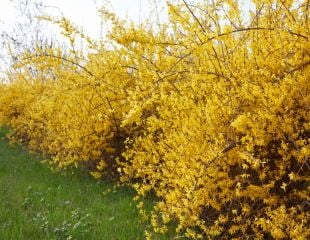
Forsythia can be planted and pruned to make a low maintenance hedge to great effect. Planted together, they make a bold splash of colour.
Forsythia does not require pruning but will respond well to pruning if you want to shape them into a hedge prune after flowering.

Forsythia is really easy to grow and a trouble free shrub, so definitely a green wheelbarrow. It is a popular and widely grown shrub, very undemanding and flowers reliably each year.
If Forsythia is not the shrub for you is not the shrub, take a look at other spring flowering shrubs.
How to Prune Forsythia
Whatever type of pruning you wish to do on a Forsythia, after flowering, is the key. This will usually be around mid/late April early May. Prune at any other time and you jeopardise the next year's flowers.
As Forsythia matures and grows larger, it can get untidy and become a tangled shrub which will benefit from being pruned. Forsythia can be pruned lightly as a tidy up, removing spindly weaker and older stems and cutting back in size. You can also hard prune Forsythia and it will respond well, and if pruning hard, it is a good idea to feed afterwards.
To keep in shape, the weaker stems can be pruned, which should be done immediately after flowering, although it is not necessary to prune Forsythia and will flower happily if left alone. In the long term Forsythia flower better with some pruning and look better.
White Forsythia Abeliophyllum.distichum
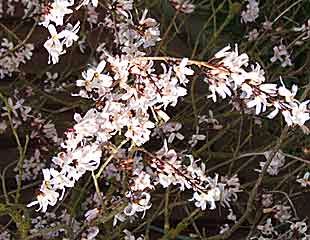
Some gardeners find the bright yellow of the Forsythia a bit too brash, in which case consider the related White Forsythia. Abeliophyllum. distichum is a white form which originates from Korea and bears fragrant white/pink flowers in spring. Although it is often referred to as white forsythia, its flowers are tinged pink.
An attractive shrub growing to about 1.5m it is fully hardy, but only as H6. Frost can damage the flowers, which can turn the emerging tips black. For this reason, although fully hardy, it is best planted in a sheltered spot and in full sun. It will grow in acid and alkaline soils and can be trained up a south facing wall.
An additional bonus is that the flowers are almond scented.
In common with the yellow variety, prune immediately after flowering as it flowers on last year's growth. If you prune after flowering, it will give more time to create growth and flowers for next year. Both varieties can a bit untidy and benefit from pruning. The white Forsythia is illustrated left, and you can see its similarity to the popular yellow Forsythia.
